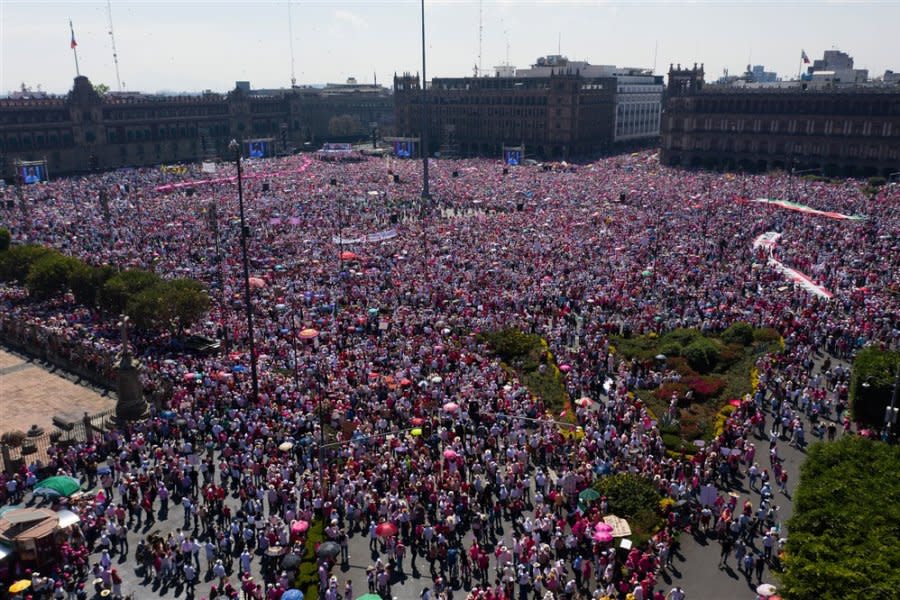Mexico City water crisis nearing 'day zero'

Feb. 25 (UPI) -- Mexico City, one of the world's largest and most densely populated cities, could be on the verge of running out of water, and prolonged drought and above-average temperatures are hastening the problem, Mexican authorities have said.
In recent days, some Mexico City residents have protested in the streets to raise awareness of the shortages where, according to local authorities, water levels are at their lowest levels in recorded history.
Protesters have taken their frustrations to the National Water Commission in Acambay, which sits in the State of Mexico, and in the Azcapotzalco municipality in Mexico City, where angry residents blocked vital roads to draw attention to the lack of water.
Water is a centuries-old issue in Mexico City. When the Spaniards settled it in the 16th century, they saw the abundance of water as an impediment to growth and so razed many of the old buildings, drained the lake bed that lies beneath Mexico City, filled in canals and cut down forests.
They saw "water as an enemy to overcome for the city to thrive," said Jose Alfredo Ramirez, an architect and co-director of Groundlab, a design and policy research organization.
Fast forward to 2024 and recent water shortages caused by higher-than-normal temperatures and prolonged drought have frightened and angered residents, some of whom say they are without water at their tap for months at a time.
Alejandro Gomez, who lives in Tlalpan, a tiny and picturesque district of Mexico City with cobblestone streets, a tiny town square dotted with trees, shops and small restaurants, said he gets a trickle of water for a few hours at a time, barely enough to fill a couple of buckets. Then, the tap will be completely dry for many days. His family exists on the water he can buy and store.
They capture their dirty bathwater to flush the toilet. "We need water. It's essential for everything," Gomez said. The weather and drought are making life even harder, he said. "Right now, we are getting this hot weather. It's even worse, things are more complicated."
Most recently, authorities have introduced significant restrictions on the water pumped from aquifers in an attempt to conserve.
"Several neighborhoods have suffered from a lack of water for weeks, and there are still four months left for the rains to start," said Christian Domínguez Sarmiento, an atmospheric scientist at the National Autonomous University of Mexico. "That is assuming the rainy season is .... rainy, which, given recent weather shifts as a result of climate change, is not a sure bet."
Many of the city's politicians have downplayed the serious nature of the water shortage, averting talk of any sense of impending crisis.
"Water shortages are not a new issue," Fausto Lugo García, Mexico City's former secretary of civil protection, said. "The capital has recurrent problems in supply and there have been times when the government [both federal and local] has to limit it, since the demand is met through the Cutzamala System, but also through wells. And even then it is insufficient."
But some water experts warn the situation has now reached such critical levels that Mexico City could hit "day zero" in a matter of months -- where the taps run completely dry for large parts of the city of 22 million, which sits, at 7,300 feet above sea level, on top of porous, clay soil, into which the city is now slowly sinking.
It is highly prone to earthquakes and the effects of climate change. Among the most densely populated places on the planet, Mexico City has been the victim of chaotic urban development and sprawl and leaky and inconsistent infrastructure, which has left its residents hanging in the balance in the face of the water shortage as demand increases.
Lugo García has acknowledged the severity of the water situation, and called on Mexico City residents to ration it and "prioritize essential actions for survival." He said people should restrict water usage to human consumption and not use it to wash cars, sidewalks or other unessential things.
But the conservation measure may be far too little too late. About 60% of Mexico City's water comes from its aquifer, which is being drained far faster than it can be replenished, according to recent research that shows the city is sinking at a rate of 20 inches per year.
Its geography and urban development have not helped matters. In the rainy season, the city is prone to flash flooding thanks to the sprawling concrete and other infrastructure, and rather than soaking into the ground and replenishing the aquifer, the rainfall does not get absorbed.
And because Mexico City and other large urban areas such as Monterrey and Guadalajara lack a rainwater harvesting system or advanced recycling methods, they are largely reliant on how much water Mother Nature gives them, and on how much residents are willing to conserve, which, no matter how many restrictions are imposed, may be enough to stay ahead of demand and the impending end of readily available water.

